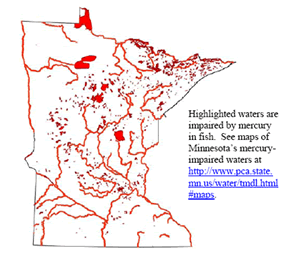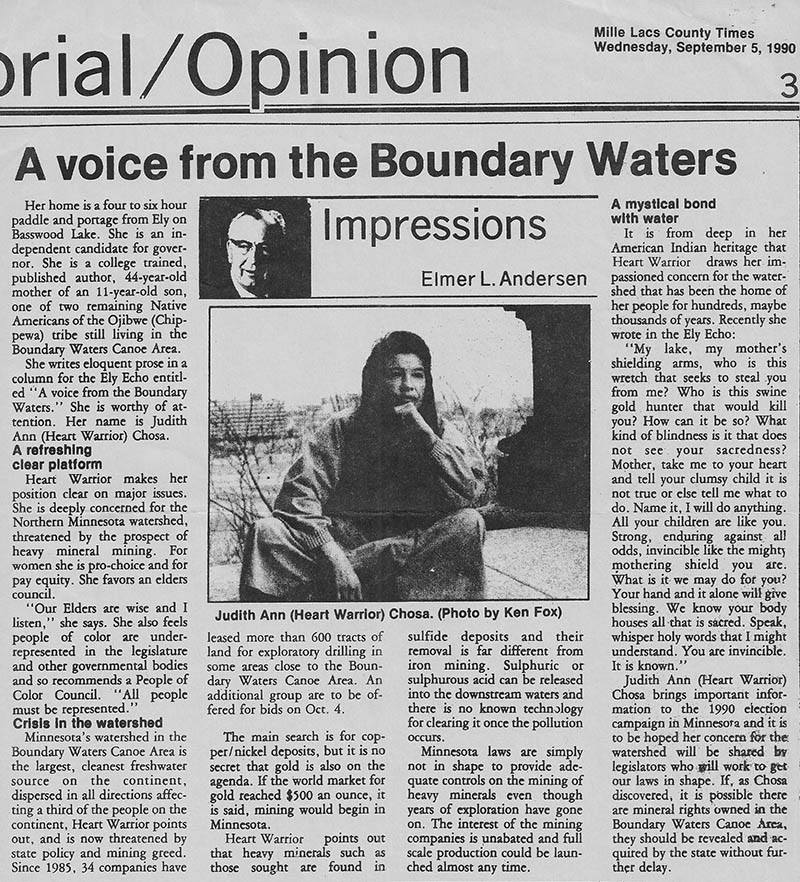A sample text widget
Etiam pulvinar consectetur dolor sed malesuada. Ut convallis
euismod dolor nec pretium. Nunc ut tristique massa.
Nam sodales mi vitae dolor ullamcorper et vulputate enim accumsan.
Morbi orci magna, tincidunt vitae molestie nec, molestie at mi. Nulla nulla lorem,
suscipit in posuere in, interdum non magna.
|
 May 1, 2013, To The Ely Echo May 1, 2013, To The Ely Echo
Dear Editor:
The Echo’s April 20 editorial contains this: “We believe the Ely area and the Boundary Waters Canoe Area make up some of best examples of heaven on God’s green Earth. None of us want to see the water that flows through these parts to be impaired in any way.” Sincere thanks to the Echo for this reminder that we are privileged to live on the edge of one of the world’s great wilderness areas. Water is the heart and soul of the Boundary Waters.
As I stated in a recent letter, Mark Twain supposedly said “A mine is a hole in the ground owned by a liar.” I do not contend that mine owners or their employees invariably lie. However, some do say things that are disingenuous and misleading. The Echo’s April 20 article about American Rivers’ recognition of the threat to the Boundary Waters quotes a Twin Metals representative as denying that metallic sulfide ore mining is a pollution threat (he called it “non-ferrous” mining, which is a term that mining boosters use in the hope that we will forget about sulfides that create sulfuric acid and sulfates). The Twin Metals representative contends that federal environmental legislation has laid to rest all pollution problems from such mines. According to the Echo, he said “the best example is the Flambeau Mine in Wisconsin. It was developed, opened, operated and closed with no environmental degradation.” That is truly creative revisionist history. If the Flambeau Mine is the best example of a non-polluting mine, we on the edge of the Boundary Waters have much to fear. In comparison to the monstrous mine that Twin Metals proposes, or even in comparison to the PolyMet project, the Flambeau Mine was tiny. It operated for only four years; it was permitted in 1991, opened in 1993, and closed in 1997. In developing and permitting the mine, the mining company and government regulatory bodies were confident that the mine design would result in no pollution. Instead, multiple monitoring sites and studies during the years since the Flambeau Mine closed show that waste from the mine has consistently polluted streams and groundwater with copper, zinc, iron, and manganese. On July 24, 2012, U.S. District Judge Barbara Crabb ruled that the Flambeau Mine had committed eleven violations of the Clean Water Act.
The April 20 Echo also quoted the Twin Metals representative as stating “There has been no mine that has been permitted post NEPA that has been on the Superfund site or has gone bankrupt.” NEPA, the National Environmental Policy Act, was passed in 1970. CERCLA, the federal statute that established the Superfund concept, was passed in 1980. Someone apparently told the Twin Metals representative that he needed to do some homework. He came back for another shot at it with a letter in the April 27 Echo, but the result was the same—he was wrong on the facts. He wrote: “[N]o hard rock mining project – like the copper nickel projects being proposed in northern Minnesota– federally permitted in the modern era of national “Superfund”regulations has posed an environmental concern or financial shortcoming that would cause it to be designated a national “Superfund” site.” In fact, here are a few examples of events that have occurred since those statutes became law. The State of Montana Department of Environmental Quality website says this about the Zortman Landusky Mines in Phillips County, Montana: “The Zortman and Landusky mines were . . . operated between 1979 and 1998 by Pegasus Gold, Inc. . . . . Following the bankruptcy of Pegasus, the State of Montana and the BLM began a co-operative effort to reclaim the mines . . . .” The Gilt Edge Mine in South Dakota, which began operations in 1986, provides a “daily double” of inaccurate statements by the Twin Metals representative. That mining company became insolvent and the mine is a Superfund site. Ditto the Summitville gold mine in Colorado. Summitville commenced large-scale open-pit operations in 1984; according to the U.S. Environmental Protection Agency website, the mine operator, Summitville Consolidated Mining Corp., Inc., “abandoned the site and announced it was filing for bankruptcy in December 1992. EPA immediately assumed responsibility of the site as an emergency response. On May 31, 1994 Summitville was placed on the National Priorities List (NPL) of Superfund sites.” What else is Twin Metals saying that is at odds with the facts?
Mining boosters assert that those who oppose sulfide mining in the watershed of the Boundary Waters are pre-judging. They sing the standard lullaby about Minnesota’s allegedly strong environmental laws and regulatory agencies. In fact, history provides no reason for anyone to have confidence that state laws and state regulators will protect our waters. When the IRRRB was sued a couple of years ago because it had violated state law by loaning money to PolyMet before environmental review, the mining company supporters in the legislature changed the law. When mining companies worried that they would not be able to meet the state standard for maximum sulfates in the water, our state government agreed to re-examine the standard even though it had been developed through rigorous scientific research. The Minnesota PCA has issued variance after variance for the Dunka Pit and for other mining pollution. Our DNR openly admits that it does not enforce limits in water withdrawal permits, in part because it is so busy issuing new permits. Within the last few weeks, Minnesota backed out of a study seeking the sources of elevated mercury levels in the St. Louis River; Minnesota’s partners in the study were the State of Wisconsin, the Fond du Lac Band, and the U.S. Environmental Protection Agency (which our governor says he wants to eliminate). Minnesota’s asserted reasons for quitting are not credible; the state said that it did not approve of the computer model being used and that state scientists wanted more time to study how mercury behaves in nature. Many believe that the real reason for the withdrawal is that taconite mining has already been identified as a source of sulfates that enable mercury pollution, and the sulfate load from taconite mining is a fraction of the sulfates that would be discharged into waters from sulfide ore mining. In other words, the state withdrew from the study because mining companies and their supporters in state government fear the study’s results will be inconvenient.
For state government to shill for mining companies by asserting in print and public statements that sulfide mining will be “done right” in Minnesota when such mining has left environmental destruction at sites around the world is an abdication of responsibility and the worst sort of pre-judging. People who oppose sulfide mining in the watershed of the Boundary Waters are not pre-judging. We can look at the existing record: the Dunka Pit, the Spruce Road site, our state government’s consistent failures to enforce our laws against mining companies, the history of the companies that seek to mine here, and, last but certainly not least, the destruction wrought by mining elsewhere.
The Echo in its April 20 editorial worries that the American Rivers recognition of the threat to the Boundary Waters will scare tourists. The Echo should instead be worrying about the threat, as business owners and so many others are.
Reid Carron
Town of Morse

A recent commentary by Minnesota Pollution Control Agency Commissioner John Linc Stine (“The MPCA’s mercury move, explained,” April 22), argued that when it comes to mercury pollution, there is “a debate about tactics, not whether to take action.” But two recent choices demonstrate a stunning lack of urgency on the part of Minnesota government. “a debate about tactics, not whether to take action.” But two recent choices demonstrate a stunning lack of urgency on the part of Minnesota government.
The MPCA’s choice to withdraw from a four-year study of mercury pollution in the St. Louis River, as well as a decision by the Minnesota Department of Natural Resources allowing Minntac to expand iron ore mining without an environmental-impact study are not supported by objective evidence.
Together, they suggest that Gov. Mark Dayton is interested in the financial health of mining companies rather than in the health of Minnesota’s pregnant women, children and the environment.
In his commentary, Stine knocked down a series of straw-person arguments while ignoring the most critical issues.
• Debate over mercury: There is no debate among scientists with the central premise. Mercury, in any amount, is a neurotoxin for developing children. A nontoxic level of exposure has never been documented. If there is a debate about anything, it is over why current guidelines aren’t revised with lower allowable exposure limits.
Does the MPCA really have independent science on mercury that is superior to the data and experiences of the U.S. Environmental Protection Agency and independent researchers? That seems a stretch. And even if it is true that the St. Louis River has unique factors that influence the availability of mercury, that’s no reason to withdraw from studying these factors alongside the EPA.
• The science just isn’t there: The tobacco industry used this argument for 50 years before the U.S. Department of Justice found it guilty of violating federal antiracketeering laws. Science is a moving target. There will never be a “final answer” to questions about mercury or any other environmental toxin. The question is whether there is sufficient evidence from multiple sources, over time, in different locations and populations, that mercury exposure causes human disease. The answer is yes. The MPCA and legislators should use the “ounce of prevention is worth a pound of cure” rule and show leadership by establishing policies that maximize the elimination of human contributions of mercury to Minnesota waterways.
• Minnesota is ahead of the pace: This doesn’t mean that the state is meeting best evidence from current independent scientists and experts. Many researchers suggest lower allowable limits for individual metals because of the likely exposure of children and adults to multiple neurotoxins in daily life. Minnesota would be showing leadership if it chose 2020 rather than 2025 for its goal of 93 percent reduction. That would be achievable and would provide an enormous benefit for our future generation’s developing brains.
When one in 10 infants on the North Shore of Lake Superior have unsafe levels of mercury in their blood, it is imperative to take action. The science of mercury toxicity is robust and indisputable, with high levels of vulnerability for pregnant women and children whose rapidly growing brains are sensitive to even small concentrations of mercury.
Stine’s argument that the EPA’s approach to studying the St. Louis River would lead us “in the wrong direction” should be more honest. Failing to evaluate the Minntac expansion and withdrawing from the St. Louis River mercury study suggests that Minnesota will go in any direction to reduce mercury — unless that direction leads us to scrutinize the mining industry.
————————-
Stephen J. Jay, of Indianapolis, is a physician and a property owner near Ely, Minn.
 I’ve been haunted by Fletcher Freeman’s letter (4/6/13 Ely Echo), in which he says that “sulfide mining is going to happen” because the rich “don’t let rules, regulations and laws get in their way.” Based on his experience with millionaires and billionaires in Texas, Fletcher knows that they can, and will, buy legislators and special favors. The rich have ways to get their way. Therefore, Fletcher argues, the best that environmentalists opposed to copper/nickel mining can hope for is “negotiating a cleanup and/or damage mitigation fund.” I’ve been haunted by Fletcher Freeman’s letter (4/6/13 Ely Echo), in which he says that “sulfide mining is going to happen” because the rich “don’t let rules, regulations and laws get in their way.” Based on his experience with millionaires and billionaires in Texas, Fletcher knows that they can, and will, buy legislators and special favors. The rich have ways to get their way. Therefore, Fletcher argues, the best that environmentalists opposed to copper/nickel mining can hope for is “negotiating a cleanup and/or damage mitigation fund.”
I suppose that Fletcher is right about how the CEOs who control Glencore, Antofagasta, and the other big international mining corporations will proceed with their plans to get richer. But I cannot accept Fletcher’s depressing conclusion that giant sulfide mines here at the edge of the BWCAW, with resultant environmental damage, are inevitable. I will continue to add my voice to many others who think that the gains of this kind of mining here are not worth the risks. Why? Because (1) I am an American who believes in democracy, (2) I am a grandfather, and (3) stuff happens:
- Our country is special because it is founded on the belief that government exists by, for, and of the people — all the people, not just the rich. I believe that my vote should count exactly the same as the vote of a rich person. I fear that our democracy is in grave danger if we allow special interests, with their legions of lobbyists and undisclosed funding of political candidates, to call the shots.
- I want to congratulate Fletcher on recently becoming a grandfather! Grandparenthood changes us. I know I want my grandkids to be able to enjoy canoe trips on pristine lakes, to be able to catch and eat a fish, to see the starry host in the dark northern sky. I do not want a grandchild to confront me, years from now, and ask why I didn’t do more to protect the BWCAW or put the brakes on global warming.
- The mining corporations can make all kinds of promises, but we all know that stuff happens: floods, explosions, human error, shortcuts to save money. In our water-rich environment, we know that water will eventually get to wherever we humans try to prevent it — and the result in this case will be damaging acid runoff.
With a new Climate Change Study Group here in Ely, I’ve been reading Storms of My Grandchildren, by climate scientist James Hansen. Alongside good science and dire forecasts, the author tells many stories of how special interests have connived to discredit and silence scientists, manipulate politicians, and postpone any meaningful legislation to slow down human-caused climate change. In other words, the gas and coal CEOs are determined to keep enriching themselves and their stockholders, democracy and grandchildren be damned! Which is just what Fletcher would expect, but just what we the people cannot accept. There’s too much at stake now to resign ourselves to the way the rich (in Fletcher’s words) play their games.
Elton Brown, Morse Township
 Photo Credit ShutterStock.com March 28, 2013 | This article was published in partnership with GlobalPossibilitie.org by AlterNet / By Joe Uehlein, Gus Speth www.alternet.org
SUMMARY:
We recognize the need to strengthen the solidarity between our movements to be successful.
It is easy to identify important national goals where our alliance must be strong and our collaboration active:
- supporting actions at the national, state, and local levels to reduce America’s climate-changing greenhouse gas emissions;
- creating healthy and safe green jobs in such areas as clean energy, transportation, and modern infrastructure;
- revitalizing America’s cities and towns through a focus on environmental quality, locally committed enterprise, community solidarity, and strong democracy;
- reforming America’s politics to reverse the growing ascendancy of money power over people power; and
- providing ample opportunities for decent work, living wages, and continuing self-improvement.
Harriet Barlow, Director Blue Mountain Center
Ron Blackwell, Former Chief Economist AFL-CIO
Jeremy Brecher, Co-Founder Labor Network for Sustainability (LNS)
John Cavanagh, Director Institute for Policy Studies (IPS)
Mijin Cha, Senior Policy Analyst Demos
Katie Corrigan, Policy Director, Kalmanovitz Initiative for Labor and the Working Poor, Georgetown University
Bob Engelman, President WorldWatch Institute
Sarita Gupta, Executive Director Jobs with Justice
Bruce Hamilton, International Vice President Amalgamated Transit Union (ATU)
Mark Levinson, Chief Economist Service Employees International Union (SEIU)
Yvette Pena Lopes, Deputy Director BlueGreen Alliance (BGA)
Bob Massie, President New Economics Institute/New Economy Coalition
Joseph McCartin, Professor, and Executive Director, Kalmanovitz Initiative for Labor and the Working Poor, Georgetown University
Bill McKibben, President and Co-Founder, and May Boeve, Executive Director and Co-Founder, 350.org
Alden Meyer, Director of Strategy and Policy Union of Concerned Scientists
Lawrence Mishel, President Economic Policy Institute
Carla Lipsig Mumme, Professor of Work and Labor Studies; York University Director, Work In A Warming World
Ken Peres, Chief Economist Communications Workers of America (CWA)
Jeremy Richardson, Kendall Science Fellow in Clean Energy Innovation, Union of Concerned Scientists
Scott Slesinger, Legislative Director Natural Resources Defense Council (NRDC)
Rosemary Sokas, MD, MOH; Professor and Chair Department of Human Science
Georgetown University School of Nursing and Health Studies
Gus Speth, Author, Professor Vermont Law School
Margrete Strand Rangnes, Vice President Public Citizen
Ananda Lee Tan, US and Canada Regional Coordinator Global Alliance for Incinerator Alternatives (GAIA)
Betsy Taylor, President Breakthrough Strategies & Solutions
Joe Uehlein, Executive Director Labor Network for Sustainability (LNS)
Mike Williams, Senior Policy and Legislative Advocate BlueGreen Alliance (BGA)
Jeremy Brecher, Co-Founder Labor Network for Sustainability (LNS)
John Cavanagh, Director Institute for Policy Studies (IPS)
Mijin Cha, Senior Policy Analyst Demos
Katie Corrigan, Policy Director, Kalmanovitz Initiative for Labor and the Working Poor, Georgetown University
Bob Engelman, President WorldWatch Institute
Sarita Gupta, Executive Director Jobs with Justice
Bruce Hamilton, International Vice President Amalgamated Transit Union (ATU)
Mark Levinson, Chief Economist Service Employees International Union (SEIU)
Yvette Pena Lopes, Deputy Director BlueGreen Alliance (BGA)
Bob Massie, President New Economics Institute/New Economy Coalition
Joseph McCartin, Professor, and Executive Director, Kalmanovitz Initiative for Labor and the Working Poor, Georgetown University
Bill McKibben, President and Co-Founder, and May Boeve, Executive Director and Co-Founder, 350.org
Alden Meyer, Director of Strategy and Policy Union of Concerned Scientists
Organizations listed for identifications purposes only
Complete Article here:
March 28, 2013
This article was published in partnership with GlobalPossibilities.org.
During our many decades of work in the labor and environmental movements, there have been many battles that led to tensions between our communities. The Keystone Pipeline is only the most recent example. To help overcome these challenges, we recently convened two dozen leaders of labor, environmental, and other organizations for a frank conversation about the difficult times faced by ordinary workers and the dire environmental prospects we all face. We were motivated by a deep conviction that our communities could unite behind a common vision of a new economy that is good for working families and for the planet. We know that a top priority of most people is decent, dignified jobs that advance a truly sustainable economy.
And, at the end of our conversation, we were heartened by the unity we found in this diverse group of leaders behind a common vision. And we hoped that by developing the following joint statement, we could help build broader consensus around this vision and steps towards achieving it.
Labor-Environment Solidarity
for a More Just and Sustainable Economy
This statement grows out of a discussion at Georgetown University on February 15, 2013 among leaders and organizers from the labor, environmental, and democracy movements sponsored by the Labor Network for Sustainability (LNS) and Georgetown’s Kalmanovitz Initiative for Labor and the Working Poor (KI).
For decades, there have been initiatives by labor and environmental leaders at local, state, and national levels to forge closer ties between these two communities, from Environmentalists for Full Employment in the 1970s to the Blue-Green Alliance and the Labor Network for Sustainability today.
Despite these efforts, there have been times of tension and conflict. The debate over the Keystone XL pipeline today is only the most recent of such moments. Many in the environmental movement have made stopping the pipeline a top priority for 2013, and many but not all in organized labor are backing the pipeline as a source of good jobs. There have been a number of instances in recent years where leaders in each of these communities have failed to acknowledge the concerns of the other.
Nonetheless, many leaders and organizers within these movements recognize that they share many values and are prepared to help define a common vision and lead a struggle for a more just and sustainable economy. In the short-term, we feel that there are many things that each community can do to advance mutual interests and concerns. Longer term, we feel that articulating a common vision for a new economy is necessary to allow these movements to serve their individual interests, but also to contribute to building a better society.
In a recent dialogue among the signers of this statement, we were struck by a common commitment to build on shared values to strengthen our solidarity by developing a shared vision, identifying obstacles and building a common agenda to move forward together.
We agree on the urgent need to build a more just and sustainable economy. We recognize the need to strengthen the solidarity between our movements to be successful. And, we are confident that an honest dialogue among leaders and activists in our movements is key to developing the shared vision necessary to strengthen our solidarity.
We recognize that the American economy is neither sustainable, nor just. We are on a climate change path that unless radically altered will lead to global warming of seven degrees Fahrenheit or greater. We are also in the most serious employment crisis since the Great Depression, wages have stagnated for over three decades and economic inequality is worse than any time since the 1920s.
We recognize that our shared goals cannot be realized without challenging the undue influence that corporations exercise over our economic system and our political process.
We also recognize the many factors that make it difficult for our movements to act in concert. Some of these affect cooperation in the short term; others are deeper and longer-term differences of perspective. Too often the cultures and organizations of the labor movement are indifferent to the challenges of sustainability. Too often, the environmental movement is inattentive to the injustice of the American economy.
Finally, despite the challenge to unity represented by the KXL pipeline, we recognize there is a larger common purpose to be served through dialogue among leaders and organizers of these movements to define and fight for an economy that works for all, but that also respects the limits of the environment we share.
Among the many labor and environmental organizations engaged in serving these shared values and realizing a common vision, the Labor Network for Sustainability is hosting a dialogue among leaders and organizers to help define an economy that realizes their shared values and to advocate for the policies necessary to serve them.
It is easy to identify important national goals where our alliance must be strong and our collaboration active:
- supporting actions at the national, state, and local levels to reduce America’s climate-changing greenhouse gas emissions;
- creating healthy and safe green jobs in such areas as clean energy, transportation, and modern infrastructure;
- revitalizing America’s cities and towns through a focus on environmental quality, locally committed enterprise, community solidarity, and strong democracy;
- reforming America’s politics to reverse the growing ascendancy of money power over people power; and
- providing ample opportunities for decent work, living wages, and continuing self-improvement.
Looking ahead, we will begin in earnest a dialogue on how to realize an America where the true and actual priorities of economic and political life are sustaining people, place, and planet; where social justice and solidarity are prized; and where peace, communities, democracy, and nature all flourish. We believe it is possible to build a new economy and a new politics. Many of the needed answers are already at hand, and others can be found. Our nation can realize a future that is equitable and ecologically balanced, but to do so we must build a movement supported by a broad base of citizens committed to transformative change. We will work together towards these ends.
Harriet Barlow, Director Blue Mountain Center
Ron Blackwell, Former Chief Economist AFL-CIO
Jeremy Brecher, Co-Founder Labor Network for Sustainability (LNS)
John Cavanagh, Director Institute for Policy Studies (IPS)
Mijin Cha, Senior Policy Analyst Demos
Katie Corrigan, Policy Director, Kalmanovitz Initiative for Labor and the Working Poor, Georgetown University
Bob Engelman, President WorldWatch Institute
Sarita Gupta, Executive Director Jobs with Justice
Bruce Hamilton, International Vice President Amalgamated Transit Union (ATU)
Mark Levinson, Chief Economist Service Employees International Union (SEIU)
Yvette Pena Lopes, Deputy Director BlueGreen Alliance (BGA)
Bob Massie, President New Economics Institute/New Economy Coalition
Joseph McCartin, Professor, and Executive Director, Kalmanovitz Initiative for Labor and the Working Poor, Georgetown University
Bill McKibben, President and Co-Founder, and May Boeve, Executive Director and Co-Founder, 350.org
Alden Meyer, Director of Strategy and Policy Union of Concerned Scientists
Lawrence Mishel, President Economic Policy Institute
Carla Lipsig Mumme, Professor of Work and Labor Studies; York University Director, Work In A Warming World
Ken Peres, Chief Economist Communications Workers of America (CWA)
Jeremy Richardson, Kendall Science Fellow in Clean Energy Innovation, Union of Concerned Scientists
Scott Slesinger, Legislative Director Natural Resources Defense Council (NRDC)
Rosemary Sokas, MD, MOH; Professor and Chair Department of Human Science
Georgetown University School of Nursing and Health Studies
Gus Speth, Author, Professor Vermont Law School
Margrete Strand Rangnes, Vice President Public Citizen
Ananda Lee Tan, US and Canada Regional Coordinator Global Alliance for Incinerator Alternatives (GAIA)
Betsy Taylor, President Breakthrough Strategies & Solutions
Joe Uehlein, Executive Director Labor Network for Sustainability (LNS)
Mike Williams, Senior Policy and Legislative Advocate BlueGreen Alliance (BGA)
Jeremy Brecher, Co-Founder Labor Network for Sustainability (LNS)
John Cavanagh, Director Institute for Policy Studies (IPS)
Mijin Cha, Senior Policy Analyst Demos
Katie Corrigan, Policy Director, Kalmanovitz Initiative for Labor and the Working Poor, Georgetown University
Bob Engelman, President WorldWatch Institute
Sarita Gupta, Executive Director Jobs with Justice
Bruce Hamilton, International Vice President Amalgamated Transit Union (ATU)
Mark Levinson, Chief Economist Service Employees International Union (SEIU)
Yvette Pena Lopes, Deputy Director BlueGreen Alliance (BGA)
Bob Massie, President New Economics Institute/New Economy Coalition
Joseph McCartin, Professor, and Executive Director, Kalmanovitz Initiative for Labor and the Working Poor, Georgetown University
Bill McKibben, President and Co-Founder, and May Boeve, Executive Director and Co-Founder, 350.org
Alden Meyer, Director of Strategy and Policy Union of Concerned Scientists
Organizations listed for identifications purposes only
February 25, 2013
 Editor The Ely Echo Editor The Ely Echo Dear Editor: Dear Editor:
Old attitudes die hard, as Joe Folio’s letter in the February 23 Echo demonstrates. Ely is rightfully proud of its iron mining history. However, the current effort to romanticize that history ignores much of its dark underside. Ironically, Mr. Folio’s letter underscores one of those darker aspects. Mr. Folio’s paean to mining and the way he says Ely used to be contains these important facts: “the mines closed and 400 people lost their jobs.” So goes the boom and bust of mining. Few things are more foolish for a community than hitching its economic wagon to the resource extraction star. Our neighbor Virginia is surrounded by mining and related activity, and Virginia has been losing population for decades; it fell from 14,034 in 1960 to 8,712 in 2010. Every census after 1960 shows a decline. Economic studies consistently prove that resource-extraction communities are poorer and less well-educated than communities that look elsewhere for economic well-being.
Further, the metallic sulfide ore mining being proposed for the Spruce Road/Kawishiwi River/Birch Lake region has little in common with the labor-intensive iron mining that occurred in and around Ely. The copper and other minerals encased in the sulfide ores are economically recoverable only because mining technology has developed to allow massive increases in output with fewer employees. If we as citizens in fact allow these mines to operate, employment will be a fraction of the employment in the iron mines, and most jobs will not go to local people. More important, as anyone who has been paying attention knows by now, metallic sulfide ore mining is a poisonous and destructive enterprise. The U.S. Environmental Protection Agency has reported that hardrock mining-which is simply another name for the metallic sulfide ore mining that the multinationals propose to inflict upon us-accounts for more than 40% of the Superfund sites in the United States.
Ely cannot have it both ways. As painful as it is for many to admit, the Boundary Waters Canoe Area Wilderness saved Ely. Mr. Folio rues the loss of population and businesses after the mines closed, but the attraction of one of the world’s great wilderness areas kept people coming here. It enabled many existing local businesses to stay afloat and inspired the creation of new businesses. Some people left Ely for careers elsewhere, were successful, and returned to invest in the community. Others who were not originally from Ely came here, saw an interesting and active community in the midst of a beautiful landscape, and laid down their cash. Those kinds of investments will come to a screeching halt when Basswood and many other lakes are polluted by the flow from the Kawishiwi, the groundwater is no longer drinkable, and gaining access to key entry points to the BWCAW requires traversing an industrial mining zone. Property values have already been hit hard in the exploration areas.
Mr. Folio repeats the common charge that people who are opposed to metallic sulfide mining here are “selfish.” Who is more selfish? People who invested significant portions of their lives and savings in businesses and property because of a pleasant community, relatively clean water and air, and a healthy forest, and who want to preserve those things in the face of a mining juggernaut? Or mining companies who will run roughshod over public and private lands, and over everybody’s water and air, to enrich themselves without regard for the businesses, homes, and lives that others have built?
Reid Carron
Town of Morse
Outdoor recreation is essential to the American economy, 11.6 billion in consumer spending in Minnesota alone. Every year, Americans spend $646 billion on outdoor recreation — on gear, vehicles, trips, travel-related expenses and more. This creates jobs, supports communities, generates tax revenue and helps drive the economy. Throughout America, people recognize that outdoor recreation and open spaces attract and sustain families and businesses, create healthy communities and foster a high quality of life.
Click to see the report on Minnesota.
To see information about other states. click on the state to see that states information.
 Opponents of copper mining in Minnesota might be winning over more state residents, according to a new poll that shows more people oppose the new kind of mining here than support it. Opponents of copper mining in Minnesota might be winning over more state residents, according to a new poll that shows more people oppose the new kind of mining here than support it.
The poll, paid for by the Minnesota Environmental Partnership and released Wednesday, found that 48 percent of state residents polled opposed copper mining while 39 percent favor the projects.
It’s the first time in five years the poll has been taken that more people opposed than supported copper mining. The coalition of 75 environmental groups conducts the survey annually to gauge public opinion on several key conservation issues.
The results show support for mining slipping from a high of 66 percent in 2009 to 62 percent in 2010, 52 percent in 2012 and 39 percent this year.
Statewide, opposition increased from 19 percent in 2009 to 48 percent this year.
The telephone poll was conducted Jan. 6-8 by the team of California-based Fairbank, Maslin, Maullin, Metz and Associates along with Alexandria, Va.-based Public Opinion Strategies. Of those people polled, 251 respondents answered the mining question. The margin of sampling error is 6.2 percent.
The question, which has been asked since 2008, was: “As you may know, new mines are being proposed near the Boundary Waters and Lake Superior. These are different from the traditional Minnesota iron ore mines. These new sulfide mining operations would be used to extract copper, nickel, and other precious metals from underground rock formations containing sulfur.
Based on this description, would you favor or oppose these new mines?”
It’s not clear what impact, if any, the poll would have on mining proposals as they advance through prospecting and regulatory stages. The issue is not expected to seriously surface during the current legislative session.
Mining supporters said they’ve seen just the opposite — growing support for the expansion into copper, nickel and other precious metals that have never been mined in the state.
“I’m not going to speak to their poll results. But everything we’ve seen as an industry, both formal and informal, shows continued strong to overwhelming support for mineral development in Minnesota,” Frank Ongaro, president of Mining Minnesota, a coalition of copper mining companies, told the News Tribune. “That public support is reflected at the local level, the state level and in elected officials at the federal level.”
But copper mining skeptics say a gradual increase in statewide news coverage and public discussion of copper mining has increased awareness of potential pollution problems.
“I think the change over the last few year shows that, the more people hear about it, the more information they get, the more questions they have,” said Steve Morse, executive director of Minnesota Environmental Partnership. “When we first started asking this question, very few people knew about the issue. Support grew a little at first, and then it’s been dropping as the state has more discussion on the potential dangers.”
Morse noted that other poll questions show strong support for strict regulations on copper mining, even among supporters. The group has not yet release results on other issues covered in the poll.
Several companies are considering mining operations in Northeastern Minnesota to extract copper, nickel, gold, platinum, palladium and other valuable metals from the so-called Duluth complex of rock. Geologists say it’s among the largest untapped deposits of those minerals in the world.
Supporters say mining the minerals will be an economic boon for the region and the entire state, creating thousands of jobs and pumping millions of dollars into the economy and state tax coffers.
PolyMet, which plans a $600 million open pit mine and processing center near Hoyt Lakes employing 350 people for 20 years or more, is the closest to reality, with a combined state/federal environmental review set to conclude this year and permits possibly issued as early as next year.
Opponents say the long-term potential for acidic runoff from copper-bearing rock, and other water pollution problems, isn’t worth the relatively short-term benefit of jobs. They say the boom-and-bust cyclical nature of the mining industry is not sustainable for the region.
The Minnesota Environmental Partnership is a coalition of more than 75 environmental and conservation organizations in the state that focus on water, energy and land conservation issues.
The poll results come as the Lake Superior Binational Forum has a public meeting set for Friday afternoon at Mesabi Range Community College in Virginia to discuss the impact of copper mining in the Lake Superior region.
By: John Myers, Duluth News Tribune
 In response: Potential risk of sulfide mining too great for local environment. The writers of the Feb. 26 Local View column, “Mining prospects spread optimism in the Northland,” wrote enthusiastically about the potential economic wealth associated with making use of the copper, nickel and other metals that are plentiful in our region. In response: Potential risk of sulfide mining too great for local environment. The writers of the Feb. 26 Local View column, “Mining prospects spread optimism in the Northland,” wrote enthusiastically about the potential economic wealth associated with making use of the copper, nickel and other metals that are plentiful in our region.
By: Susan Nordin, for the News Tribune
The writers of the Feb. 26 Local View column, “Mining prospects spread optimism in the Northland,” wrote enthusiastically about the potential economic wealth associated with making use of the copper, nickel and other metals that are plentiful in our region.
However, they failed to mention the negative impacts the mining of those metals could have in the form of pollution, environmental harm, human health issues and the potential of cleanup costs that would have to be paid for by taxpayers when the mining is done.
On the same page, the News Tribune’s editorial (Our View: “Unlikely coalition shows mining urgency”) included a quote suggesting environmental messes connected to metals mining happened decades ago, before the Clean Water Act. That would be simply incorrect. Mine pollution requiring expensive cleanup has occurred since the Clean Water Act in numerous states, including Arizona, Utah, Nevada and New Mexico.
As a physician, I am concerned about the potential health effects of sulfide mining. I am alarmed that the proposed mines would be so close to the Boundary Waters Canoe Area Wilderness and the tributary waterways that flow into the St. Louis River and, ultimately, into Lake Superior.
Will the mining companies spend a lot of money trying to offset potential pollution around the mines? Of course. But unfortunately, accurately predicting the ultimate deleterious effects of acid-mine drainage is very complex. Despite the best science and resources spent to avoid it, acid-mine drainage remains a main source of environmental damage related to sulfide mining. Unlike iron mining, sulfide mining for copper produces sulfuric acid and releases metals that can enter waterways near mines. This can seriously affect fish and marine habitats and water quality, and this can have unknown effects on human health.
Arsenic, manganese and thallium are present in some acid-mine drainage. High levels of these metals in drinking water definitely affect human health and can cause illness.
Frighteningly, mining companies struggle to cite a single example of a sulfide mine that has not produced polluted drainage. Are we willing to risk our own main source of fresh water in exchange for money?
There is a reason the BWCAW is protected. Not only does it provide habitat for animals and fish, it offers a place of refuge and rejuvenation for human beings, which is important for optimal health. The wilderness area is a vital part of what draws people to this region and is a large source of revenue in tourism. Sulfide mining risks polluting and spoiling our wilderness area.
There are examples in Montana and Colorado of unintended acid-mine drainage leaving miles of river devoid of fish and aquatic life. Can something like that be mitigated? Do we want to risk that happening in Minnesota?
The cost of mitigation also is a concern. It is tempting to think about the potential economic gains that come with mining, but mining companies elsewhere have declared bankruptcy and left taxpayers responsible for cleanup.
I recognize the need for copper and other metals in society. I am not “anti-mining.” However, the potential risk of sulfide mining to our local environment and source of fresh water bears serious thought. The price of sulfide mining is too high. There are too many risks, and there’s a lack of evidence that sulfide mining will not cause irreparable environmental harm and risk to human health.
Susan Nordin of Duluth is a family physician for the University of Minnesota School of Medicine concerned about the potential for health impacts related to precious-metals mining.
 Benefits ONLY! We forgot Costs. The latest report from the UMD Labovitz School of Business and Economics (as reported on by the News Tribune in the Feb. 7 story, “UMD report underscores value of iron ore mining, potential for copper”), is business as usual in the world of mining in Minnesota.
Once again we get a promotional brochure for the mining industry masquerading as an economic report.
To make judgments about proposed industrial developments, the civilized world usually agrees that a cost-benefit analysis is required. But all we get from the University of Minnesota Duluth is a list of benefits. There was no apparent discussion of costs, of elevated sulfates in Lake Vermilion or of heavy metals leaching from the Dunka pit. I noticed no hint of the dead zone for wild rice in the St. Louis River, no analysis of the blighted communities along the length of the Mesabi Range and no acknowledgement of the poverty rate in Virginia, the heart of the Mesabi Range.
“Regulatory capture” refers to the industry domination of agencies meant to regulate them. “Deep capture” occurs when the industry dominates the media, academia and popular culture. It seems to me the state of Minnesota has been captured by the mining industry.
The editorial pages of the Duluth News Tribune and the publications of the Labovitz School of Business and Economics should be
 Who pays-dictate the results! adequate proof of Minnesota’s subjugation to mining interests.
Robert Tammen
Soudan
Published February 25, 2013, 12:00 AM
Reader’s view: Business as usual for Minnesota mining
The latest report from the UMD Labovitz School of Business and Economics (as reported on by the News Tribune in the Feb. 7 story, “UMD report underscores value of iron ore mining, potential for copper”), is business as usual in the world of mining in Minnesota.
The greatest freshwater eco-system in the U.S. is STILL threatened by state policy and mining greed. Heart Warrior was sounding the alarm in 1990.

|
|
 May 1, 2013, To The Ely Echo
May 1, 2013, To The Ely Echo

 “a debate about tactics, not whether to take action.” But two recent choices demonstrate a stunning lack of urgency on the part of Minnesota government.
“a debate about tactics, not whether to take action.” But two recent choices demonstrate a stunning lack of urgency on the part of Minnesota government. I’ve been haunted by Fletcher Freeman’s letter (4/6/13 Ely Echo), in which he says that “sulfide mining is going to happen” because the rich “don’t let rules, regulations and laws get in their way.” Based on his experience with millionaires and billionaires in Texas, Fletcher knows that they can, and will, buy legislators and special favors. The rich have ways to get their way. Therefore, Fletcher argues, the best that environmentalists opposed to copper/nickel mining can hope for is “negotiating a cleanup and/or damage mitigation fund.”
I’ve been haunted by Fletcher Freeman’s letter (4/6/13 Ely Echo), in which he says that “sulfide mining is going to happen” because the rich “don’t let rules, regulations and laws get in their way.” Based on his experience with millionaires and billionaires in Texas, Fletcher knows that they can, and will, buy legislators and special favors. The rich have ways to get their way. Therefore, Fletcher argues, the best that environmentalists opposed to copper/nickel mining can hope for is “negotiating a cleanup and/or damage mitigation fund.”
 Editor The Ely Echo
Editor The Ely Echo Dear Editor:
Dear Editor: Opponents of copper mining in Minnesota might be winning over more state residents, according to a new poll that shows more people oppose the new kind of mining here than support it.
Opponents of copper mining in Minnesota might be winning over more state residents, according to a new poll that shows more people oppose the new kind of mining here than support it. In response: Potential risk of sulfide mining too great for local environment. The writers of the Feb. 26 Local View column, “Mining prospects spread optimism in the Northland,” wrote enthusiastically about the potential economic wealth associated with making use of the copper, nickel and other metals that are plentiful in our region.
In response: Potential risk of sulfide mining too great for local environment. The writers of the Feb. 26 Local View column, “Mining prospects spread optimism in the Northland,” wrote enthusiastically about the potential economic wealth associated with making use of the copper, nickel and other metals that are plentiful in our region.

